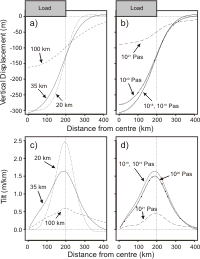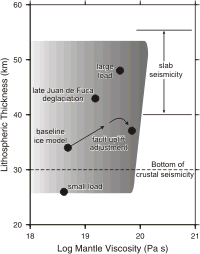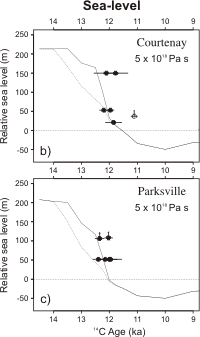Proactive disclosure
Print version   |  | 
Natural Resources Canada > Earth Sciences Sector > Priorities > Strong and safe communities > Geodynamics
Geodynamics Postglacial rebound at the Northern Cascadia Subduction Zone
Thomas S. James, John J. Clague,
Kelin Wang, Ian Hutchinson
GSC, Contribution Series 1998125
A postglacial rebound model is developed to explain tilted shorelines of
proglacial lakes and relative sea level change at the northern Cascadia
subduction zone. The modelling shows that mantle viscosity in this tectonically
active region, which features a relatively youthful oceanic plate (6 Ma at the trench),
is less than 1020 Pa s. As a consequence of the low mantle viscosity and
resulting rapid isostatic recovery, present-day postglacial rebound uplift rates are
predicted to be less than 0.1 mm/yr, in contrast to earlier models predicting rates
of a few millimeters per year. The relative sea-level observations require rapid
collapse of remaining marine-based portions of the ice sheet around 12.5 to 12.25 ka.
The Cascadia subduction zone is a region of enhanced seismic hazard.
Consequently, it is the focus of a variety of geodetic investigations,
including continuous GPS monitoring. Before crustal motion observations
can be interpreted in terms of plate-boundary-related crustal deformation,
however, it is necessary to estimate and remove the signal from other
processes that may produce detectable crustal motion. Surface loading
from ice sheets (glacial isostasy) can potentially produce vertical crustal
motion at the millimeter per year level.
A glacial rebound model is developed to explain the crustal tilting and
uplift that occurred at the northern Cascadia subduction zone during retreat
of the Cordilleran ice sheet at the end of the Pleistocene. A good fit
to the observations is obtained with mantle viscosity values ranging from
5 x 1018 Pa s to 5 x 1019 Pa s. This
is consistent with studies of crustal deformation following subduction
zone earthquakes, but is ½ to 2 ½ orders of magnitude smaller
than the viscosity typically attributed to the upper mantle underlying
tectonically less active regions (1020 to 1021 Pa s). Owing to the low
viscosity values, our model predicts present-day crustal uplift rates
of the order of 0.1 mm/yr or less, much smaller than the predictions of
a global postglacial rebound model that were previously used to adjust
geodetic observations from northern Cascadia.

Tectonic setting
|
Tectonic setting of the northern Cascadia subduction zone, where the Juan de Fuca
plate subducts beneath North America. Data analyzed in this study include
tilts of proglacial lake shorelines in Puget Sound (profiles RH and Br)
and relative sea level observations at Courtenay and Parksville.

Ice sheet baseline model
|
The baseline ice sheet model developed in this study at the glacial maximum
about 14 ka (heavy line). Ice sheet thicknesses (m) are given for each
grid element. Model thicknesses are given at 13 other times between 25
and 10.5 ka. The large circular disks are for ICE-3G (Tushingham and Peltier,
1991), a postglacial rebound model previously used to correct geodetic
observations in the region.
Sketches of the effect of a glacial load on the Earth:

Peak glaciation
|
(a) At peak glacial conditions the Earth's surface is depressed beneath
the ice sheet and slightly elevated outside the ice sheet owing to mantle flow.

Deglaciation
|
(b) During deglaciation the depressed region rises and peripheral regions
subside. Uplift of the Earth's surface is frequently observed as relative
sea level fall in recently deglaciated areas. During the initial stages
of recession proglacial lakes formed in the Puget Lowland. Shoreline features
of these lakes are now tilted up to the north.
| Proglacial lake shorelines |

Lake location map
|
(a) Location of Lake Russell-Hood (triangles) and Lake Bretz (diamonds)
proglacial lake shoreline sites in the Puget Lowland (Thorson, 1989).
The projection of the Seattle thrust fault is shaded.

Lake Russell Hood linear regression
|
(b) Linear regression (filled triangles and solid line) showing the tilt
of present-day shoreline elevations for Lake Russell-Hood. Also shown
is the linear regression after northern Lake Russell-Hood sites are corrected
for possible movement on the Seattle fault (open triangles and dotted
line).

Lake Bretz linear regression
|
(c) Linear regression for western Lake Bretz.
| Crustal displacement and crustal tilt |

Crustal displacement and tilt
|
(a and b) Crustal displacement and (c and d) crustal tilt resulting from
a circular disk of ice whose size and duration of loading is chosen to
approximate that of the southwestern Cordilleran ice sheet. In the left-hand
panels the mantle viscosity is 1018 Pa s and the
lithospheric thickness is varied, while in the right-hand panels the lithospheric
thickness is 35 km and the mantle viscosity is varied. It is difficult
to obtain the observed tilt of about 1 m/km if the lithosphere is too
thick or the mantle viscosity too large.

Predicted shoreline tilts
|
Predicted shoreline tilts (in m/km) for (a) Lake Russell-Hood and (b)
western Lake Bretz for a range of mantle viscosity values and lithospheric
thicknesses for the detailed ice sheet model.
Observed tilts, shown as heavy lines, are 0.85 m/km for Lake Russell-Hood
and 1.15 m/km for western Lake Bretz (see figures
b and c on proglacial shorelines). Point A indicates the baseline
solution satisfying both lake tilts and Point B shows the solution when
the effect of slip on the Seattle Fault is included (see figure b on proglacial shorelines).
| Mantle viscosity and lithospheric thickness |

Mantle viscosity
|
Mantle viscosity and lithospheric thickness results of varying a number
of model assumptions. The shaded region indicates the range of likely
solutions, taking into account combinations of various effects. Seismicity
depth ranges are given for western Puget Sound. An upper bound on mantle
viscosity in this region is about 1020 Pa s.
| Relative sea-level observations |

Relative sea-level
|
Relative sea-level observations at Courtenay and Parksville compared
to model predictions for the baseline ice sheet and three mantle viscosity
values. The sea level observations also require a mantle viscosity less
than 1020 Pa s.
| Ice sheet volume history and relative sea-level predictions |

Ice Sheet Volume History
|
(a) The ice sheet volume history, expressed as meters of sea-level equivalent,
for the baseline ice sheet (solid line) and a variant in which deglaciation
occurs relatively uniformly (dotted line).

Relaitve sea-level predictions
|
(b) and (c) Relative sea-level predictions at Courtenay and Parksville
for the two ice sheet histories and a mantle viscosity of 5 x 1018
Pa s. Rapid deglaciation around 12.5 to 12.25 ka is needed to explain
the observed sea level change.
| Predicted present day crustal uplift |

Baseline model
|

ICE-3G
|
Predicted present-day crustal uplift (mm/yr) for (a) the baseline ice
sheet and a 1020 Pa s mantle viscosity, and (b) the ICE-3G deglaciation
history and a 1021 Pa s upper mantle viscosity.
A postglacial rebound model developed to explain tilted shorelines of
proglacial lakes and relative sea level change at the northern Cascadia
subduction zone reveals:
- Mantle viscosity in this tectonically active region, which features
a relatively youthful oceanic plate (6 Ma at the trench), is less than 1020 Pa s.
- As a consequence of the low mantle viscosity and resulting rapid isostatic
recovery, present-day postglacial rebound uplift rates are predicted to
be less than 0.1 mm/yr, in contrast to earlier models predicting millimeter per year rates.
- The relative sea-level observations require rapid collapse of remaining
marine-based portions of the ice sheet around 12.5 to 12.25 ka.
Thorson, R. M., Glacio-isostatic response of the Puget Sound area, Washington,
Bulletin of the Geological Society of America 101, 1163-1174, 1989.
Tushingham, A. M., and W. R. Peltier, ICE-3G: A new global model of late
Pleistocene deglaciation based upon geophysical predictions of post-glacial
relative sea level change, Journal of Geophysical Research 69, 4497-4523,
1991.
Dr. Thomas S. James works in the Geodynamics Section of the
Geological Survey of Canada (Sidney), British Columbia.
Dr. Kelin Wang works in the Cordilleran Tectonics Section of the
Geological Survey of Canada, Sidney, British Columbia.
Dr. John J. Clague works in the Earth Sciences Department at Simon Fraser University, Burnaby, British Columbia.
Dr. Ian Hutchinson works in the Geography Department at Simon Fraser University, Burnaby, British Columbia.
|
